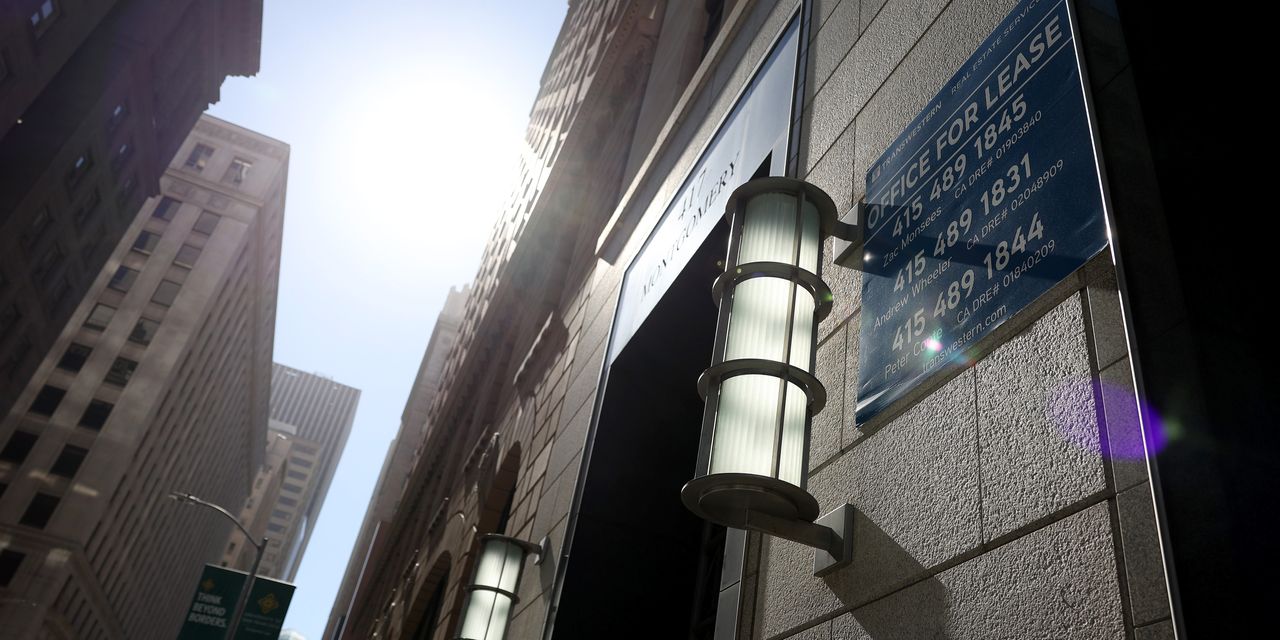Commercial real estate’s link to smaller banks in the U.S. is vulnerable and has not gotten enough attention after recent strain in the banking system, according to Capital Economics.
“Lending to commercial property in the U.S. is dominated by the country’s small and mid-tier banks,” with smaller U.S. banks accounting for 70% of outstanding loans to the commercial real- estate sector, Neil Shearing, group chief economist at Capital Economics, said in a note Monday. A pullback in lending would likely add “downward pressure on capital values,” he said.
“But in a worst case scenario it’s possible that a ‘doom loop’ develops between smaller banks and commercial property, in which concerns about the health of these banks leads to deposit flight,” warned Shearing. That, in turn, would cause “banks to call in commercial real estate loans, which then accelerates a downturn in a sector that forms a key part of its asset base, which intensifies concerns about the health of the banks and thus completes the vicious cycle.”
Property-sector problems have figured into “the heart of major crises” historically, said Shearing, citing the global financial crisis of 2007 – 2008, the U.S. savings and loans crisis in the 1980s and 1990s, the U.K.’s “secondary banking crisis” of 1973-1975 and “the Great Crash of 1929.”
“If property is to be the source of deeper strains in the banking system, the place to look may be commercial real estate,” he said. “This has become a focus of concern in recent days, particularly in the U.S., but the linkages with the banking system – which is the real source of vulnerability – have not received sufficient attention within the debate.”
Pullback in lending?
The commercial real-estate market includes industrial and retail properties as well as offices and apartments, according to Capital Economics. In Shearing’s view, lending to commercial real estate may tighten as smaller banks experience pressure on their deposit base following the run on failed Silicon Valley Bank earlier this month.
“The immediate focus has been on the risk of deposit flight caused by concerns about the health of mid-tier banks in the wake of the collapse of SVB and worries about uninsured deposits in excess of the federally-insured limit” of $250,000, he said.
“But this has obscured a broader problem,” said Shearing, “which is that higher interest rates are causing a shift out of bank deposits and into money market funds as interest rates on short-dated securities rise faster than those on commercial bank deposits.”
Read: Bank ETFs fall amid concerns over SVB and ‘crack’ in financial system after rate hikes
That’s left banks “in a bind” that will probably lead to tightening of financing in the commercial real estate sector, according to the note. Banks will either need to raise their deposit rates “in line with money markets and try to maintain profits by increasing rates on loans that are due to refinance, or they shrink the asset side of their balance sheet in order to accommodate a smaller deposit base.”
Commercial-property lending accounts for about 40% of all loans by smaller U.S. banks, according to Capital Economics. Smaller U.S. banks are those defined by the Federal Reserve as being outside the 25 biggest by asset size, the note says.
Meanwhile, commercial real-estate prices in the U.S. have broadly fallen 4% to 5% from their peak in mid-2022 and Capital Economics expects a further 18% to 20% drop from here for a “peak-to-trough fall of around 22%,” according to the note. Office properties could see the worst of the decline, a chart in the note shows.
CAPITAL ECONOMICS NOTE ON MARCH 27, 2023
“Risks emanating from the property sector are very different from those 15 years ago, and the consequences are likely to be far less damaging to the real economy,” said Shearing. “But in the hunt for the next shoe to drop, commercial real estate – and its linkages to small and mid-tier banks – looms large.”
Shares of the SPDR S&P Regional Banking ETF
KRE,
have tumbled this month, with a year-to-date drop of around 25% based on Monday morning trading, according to FactSet data, at last check.
The U.S. stock market was trading mostly higher late morning Monday, after booking gains last week. The S&P 500
SPX,
was up 0.2% in late morning trade Monday, while the Dow Jones Industrial Average
DJIA,
rose 0.6% and the technology-heavy Nasdaq Composite
COMP,
fell 0.3%, according to FactSet data, at last check.
“A degree of calm has returned to markets over the past week, but some sense of nervousness persists,” Shearing said.
Read: There’s another looming cliff — the end of the student-loan repayment moratorium
Also see: ‘Some losses’ in commercial real estate and Treasurys may still need to work ‘through the banking sector,’ says Fed’s Kashkari
Read the full article here










